Owls have been swooping through the night skies for tens of millions of years. They are found on every continent except the frozen deserts of Antarctica. These ancient birds are raptors, or birds of prey. Like hawks and eagles, they use their razor-sharp talons and curved beaks as weapons to hunt, kill, and tear apart their prey.
Although owls and other birds of prey share common traits, owls exhibit many characteristics that set them apart from other raptors. Genetically, owls are entirely separate from hawks. They are classified in their own order, Strigiformes, and are among the oldest group of living birds. Owls are fluffier than other raptors because they have special feathers that make them virtually silent.
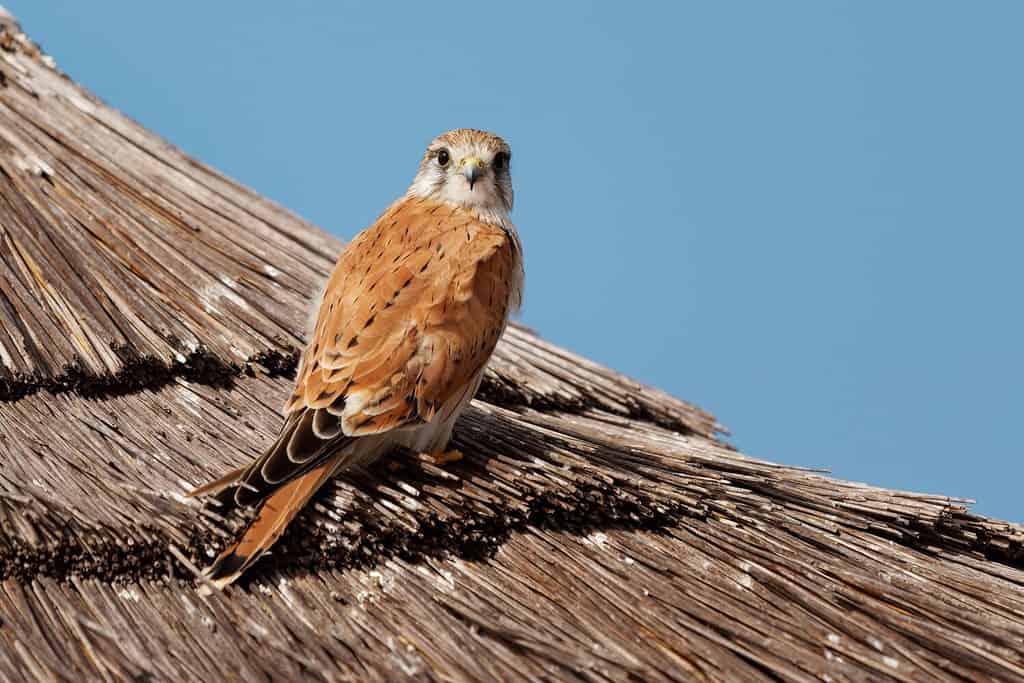
Owls differ from other raptors, such as this kestrel, by characteristics such as their forward-facing eyes and large heads.
©Martin Pelanek/Shutterstock.com
Unlike other raptors, most owls are active at night. They have large heads with eyes that face forward, like humans. They have stockier bodies than hawks and a reversible toe that can point either forward or backward. Physically, the differences between owls and other birds of prey are obvious to any observer. The owl’s signature call, however, gives them away without ever being seen.
That familiar “hoot, hoot” is perhaps the one bird call everyone in the world can identify. Of the 250 species of owls worldwide, 19 call the United States home, according to the American Bird Conservancy. Oregon is fortunate enough to have 14 of the country’s 19 types of owls living at least part of the year in this Pacific Northwest state.
From extremely rare species listed as globally vulnerable to everyday, familiar faces, discover the 14 types of owls in Oregon from the rarest to the most common.
#1 Snowy Owl

Snowy owls only visit Oregon from their Arctic homeland every few years. This makes them the rarest of the types of owls in Oregon.
©Carol Gray/iStock via Getty Images
The largest North American owl, the snowy owl, is as breathtaking as it is rare in Oregon. Its snowy white plumage camouflages the bird as it hunts throughout its high Arctic tundra environment. While adult males are virtually all white, females have black spots and barring. Their glowing yellow eyes could be mistaken for a cat’s gaze. Its favorite meal is a small arctic rodent called a lemming, but its diet is varied and can include animals as large as geese.
Certainly not a full-time resident of Oregon, the snowy owl invariably attracts media attention when it appears in cities south of the Canadian border during some winters. For reasons still not fully understood, these Arctic hunters can be found every few years on Oregon’s coastal dunes, open high desert, agricultural areas, airport margins, and perched above cities atop buildings.
Listen to the squeaky call of the snowy owl.
#2 Northern Spotted Owl
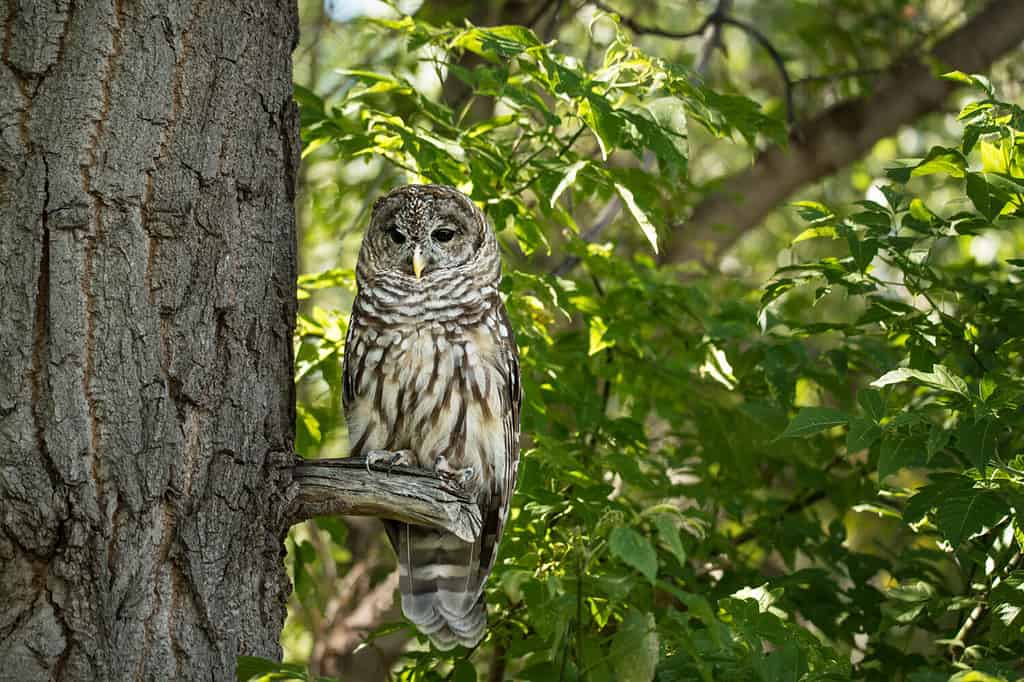
The northern spotted owl is the most controversial owl in Oregon because of the conservation efforts put forth to preserve its old-growth forest habitat.
©Georgia Evans/Shutterstock.com
The largest of the three subspecies of spotted owls, the northern spotted owl is an indicator species for the health of old-growth forests. Because these birds depend on structurally complex, old-growth forests from southwestern British Columbia to northern California, their declining population reflects the health of their habitats.
Northern spotted owls are long-lived birds that invest heavily in caring for their young. They have dark eyes and chocolate-brown feathers with round, white spots on their heads, necks, backs, and underbelly. As a permanent resident in the forested regions of western Oregon, it is also listed as federally threatened and is an Oregon Conservation Strategy Species of conservation concern.
Listen to the call of the Northern spotted owl.
#3 Western Burrowing Owl
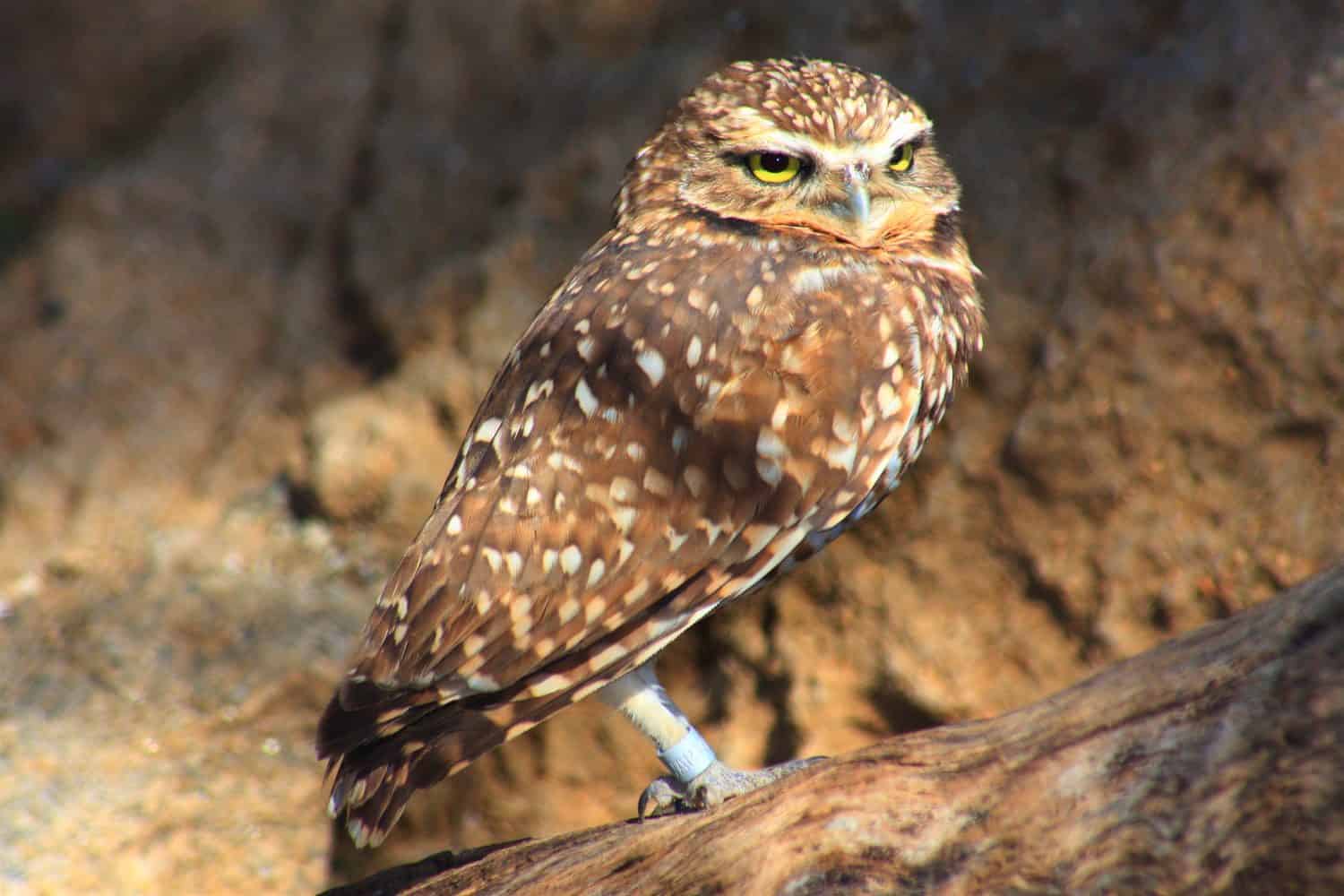
As their name suggests, western burrowing owls nest in underground burrows.
©Larry B. King/Shutterstock.com
While many owls nest in alcoves they find in trees, western burrowing owls in Oregon nest in underground burrows they’ve either dug themselves or commandeered from badgers, a major predator of burrowing owl eggs and young. They live in open shrub-steppe regions and grasslands feeding on insects and rodents. Western burrowing owls are small, sandy-colored birds with long legs and bright yellow eyes.
Western burrowing owls are federally listed as a species of concern and an Oregon Conservation Strategy Species in the Blue Mountains, Columbia Plateau, and Northern Basin and Range ecoregions.
Listen to the sound of a burrowing owl.
#4 Flammulated Owl
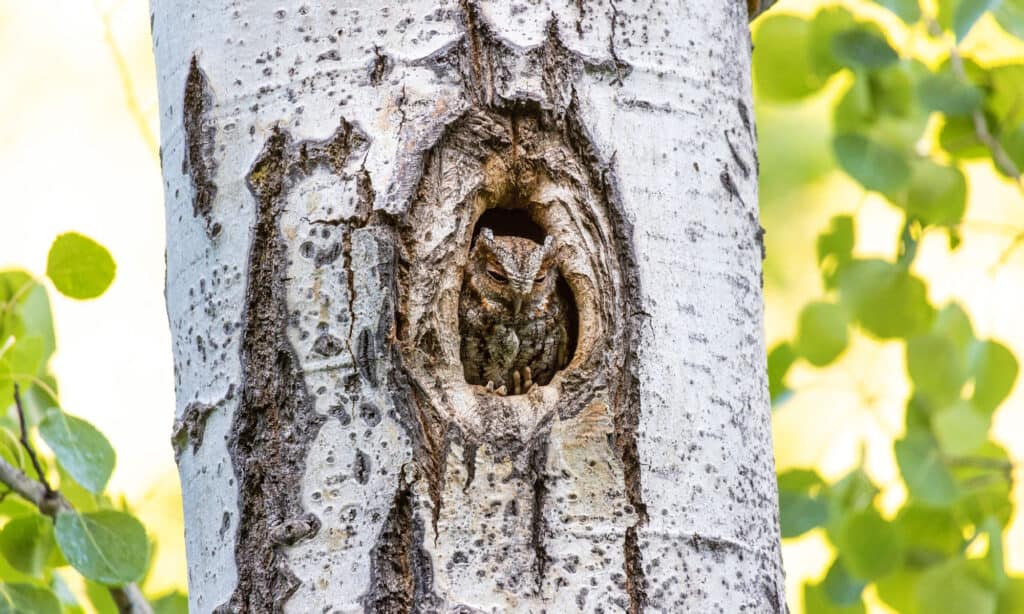
The tiny flammulated owl is an insectivores.
©iStock.com/Devonyu
One of the smallest owls in North America, the flammulated owl has a body mass of about 1.9 ounces. Unlike most other Pacific Northwest species of owls, these diminutive birds feed almost exclusively on insects. It has conspicuous ear tufts, dark eyes, and brown plumage. There is some variation among the species with darker or reddish feathers.
In the winter, flammulated owls migrate to Mexico and Central America. They breed on the eastern slope of the Cascades, in the Blue and Wallowa mountains, and in small numbers in the mountains of southwest Oregon. It is an Oregon Conservation Strategy Species in the Blue Mountains, East Cascades, Klamath Mountain, and West Cascades ecoregions, according to the Oregon Department of Fish and Wildlife.
Listen to the call of a flammulated owl.
#5 Great Gray Owl

Great gray owls are the largest owls in Oregon by length.
©Lynn_Bystrom/iStock via Getty Images
Uncommon in Oregon, it is the state’s largest owl by length. Its size is somewhat an illusion, however, as its thick, fluffy, silvery-gray plumage covers a body weighing only 2.5 pounds. Preying mostly on tiny rodents, this magnificent night bird has piercing yellow eyes set in a black-outlined, prominent facial disc. It is a powerful bird able to break through hard snow to snatch a small mammal.
The great gray owl is an Oregon Conservation Strategy Species in the Blue Mountains, East Cascades, Klamath Mountains, and West Cascades ecoregions.
Listen to the call of a great gray owl.
#6 Short-Eared Owl
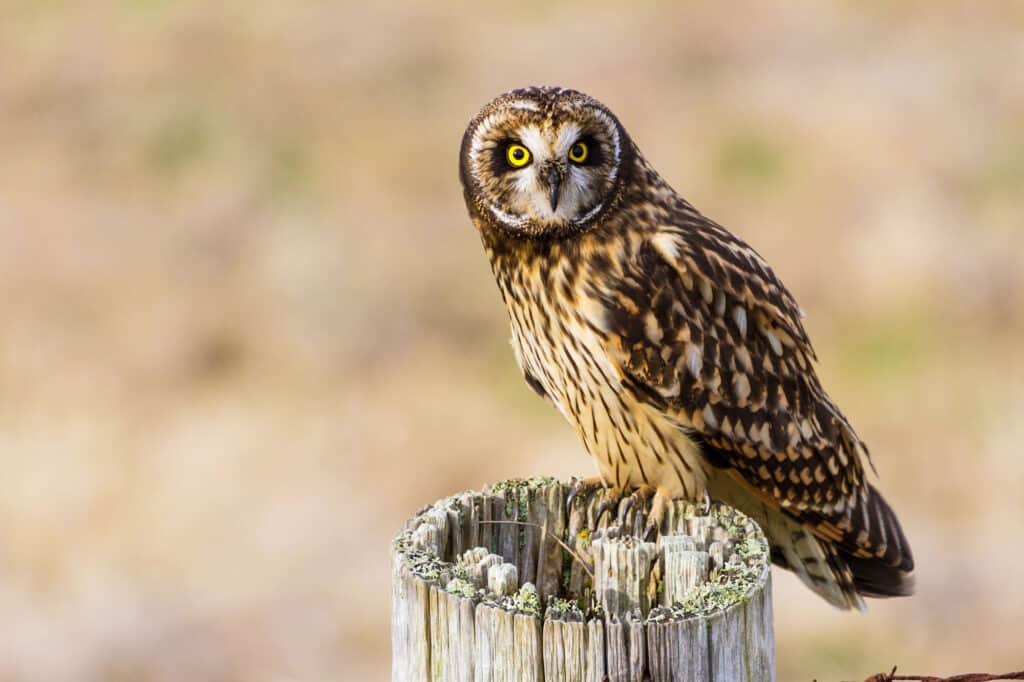
The short-eared owl is a diurnal hunter, meaning it is active during the day.
©iStock.com/Devonyu
The short-eared owl was named for the small “ear” tufts that point up from the middle of its forehead. In Oregon, it lives in the Willamette Valley and east of the Cascade Mountains. Usually spotted by day, these owls nest on the ground under shrubs or grass. They have black-rimmed yellow eyes set within a pale facial disk.
Short-eared owls are locally common to rare in open country throughout Oregon. It is locally common in the breeding season east of the Cascades, especially in the large wetland complexes. They are unique among owl species as they are more likely to be seen than heard.
Listen to the call of the short-eared owl.
#7 Boreal Owl
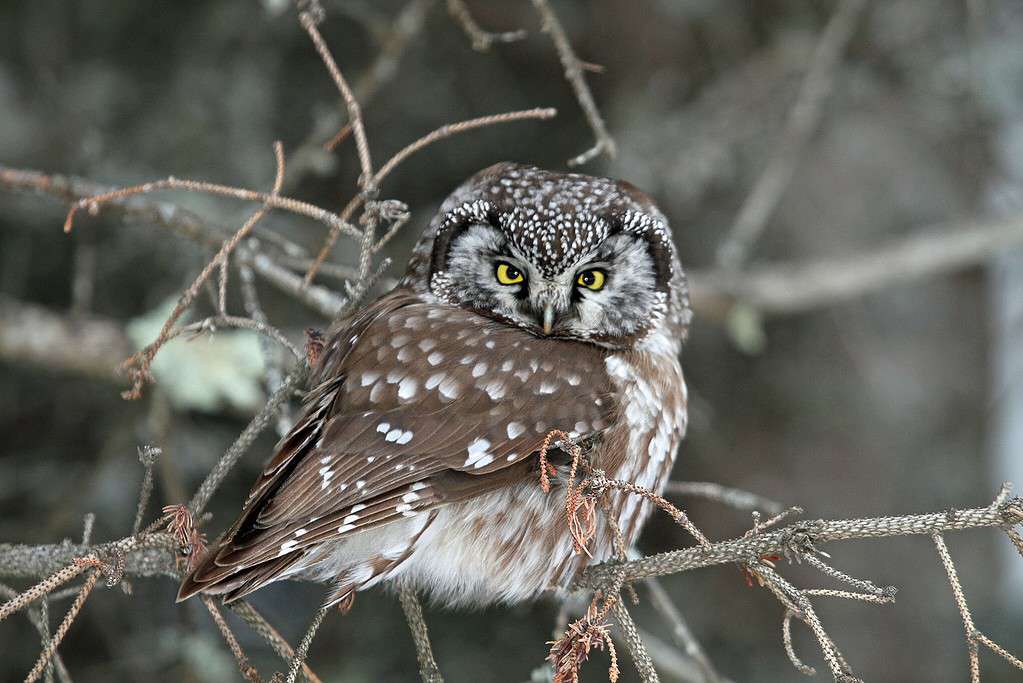
Boreal owls were named after the Greek god of the north wind.
©Greg Schechter / CC BY 2.0 – License
Named for the winged Greek god of the north wind, Boreas, the boreal owl is a rare sight in northeast Oregon. A mysterious owl of dense, northern woodlands, these strictly nocturnal owls were not discovered south of Canada until the 1980s. They are now presumed to be a permanent resident of Oregon.
Boreal owls are small, chunky, and earless. They are brown with a large, square-topped head, and a black-framed gray face. These elusive predators live in remote forests above 5,000 feet. Surveys have found boreal owls in the Wenaha-Tucannon Wilderness in northeast Umatilla and northwest Wallowa counties, and on the south slopes of South Sister Mountain in Deschutes County. They also live in the Willamette, Deschutes, and Umatilla national forests, according to the Oregon Department of Fish and Wildlife.
Listen to the call of the boreal owl.
#8 Barred Owl

Barred owls have a distinctive hoot that sounds like “who cooks for you.”
©Lynn_Bystrom/Shutterstock.com
Barred owls are non-native owls once restricted to the eastern United States. First reported in Oregon in the 1970s, they are now permanent residents in forests of western and northeast Oregon. Nearly as large as the great horned owl, the stocky barred owl lacks ear tufts and differs in coloration. It is brown to gray overall, with dark eyes, and pronounced horizontal striping on its throat and upper breast.
These owls hunt at night and are instantly recognizable for their signature “who cooks for you” hoot.
Listen to the sound of a barred owl.
#9 Long-Eared Owl
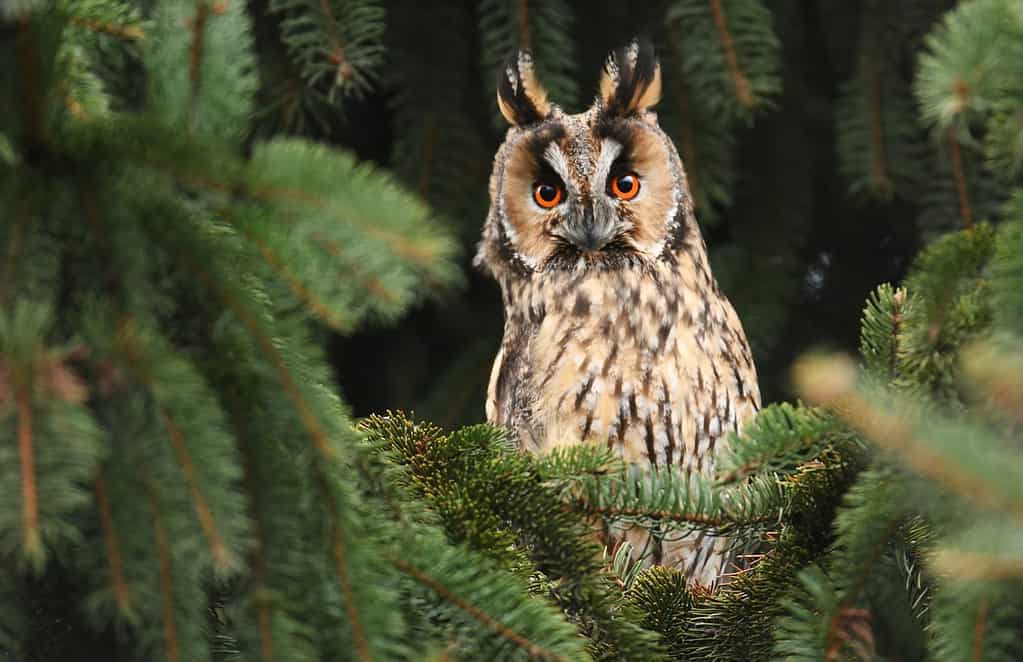
Long-eared owls can hunt successfully in complete darkness.
©Piotr Krzeslak/Shutterstock.com
As its name suggests, this superbly camouflaged, nighttime hunter sports long “ear” tufts on top of its round facial disk. It is a medium-sized owl with black, brown, gray, and white coloring. Their incredible hearing allows them to snatch up small mammals in complete darkness. They swallow their prey whole, then regurgitate the fur and bones.
Long-eared owls in Oregon live east of the Cascade Mountains in wooded riparian areas and junipers. They range extensively in the Northern Hemisphere.
Listen to the sound of a long-eared owl.
#10 Northern Pygmy Owl

Northern pygmy owls have a reputation as bold and aggressive predators that can hunt animals more than twice their size.
©Jordan Feeg/Shutterstock.com
Tiny but mighty, Oregon’s smallest owl is an aggressive predator that can take mammals more than twice its size. Only about the size of a sparrow, the northern pygmy owl is mainly active during the day. It is common throughout forested areas of Oregon.
Coloration is variable in the state from dark brown in the coastal mountains to gray in eastern Oregon. They have yellow eyes and a yellowish-white beak. To confuse predators, northern pygmy owls have two black spots shaped like eyes on the back of their heads.
Listen to the call of a northern pygmy owl.
#11 Western Screech Owl

Western screech owls have plumage that makes them blend in with tree bark so well they almost disappear.
©Steve Bruckmann/Shutterstock.com
Thanks to their magnificent camouflage, the western screech owl is more common than many are aware. These owls are almost strictly nocturnal. They are small with stocky bodies that occasionally hunt prey larger than they are, such as cottontail rabbits.
Western screech owls have streaked plumage that makes them virtually indistinguishable from tree bark. They have yellow eyes and feathered ear tufts. Most common in woodlands and forests throughout Oregon, they will nest in suburbs and cities in large trees and other structures.
Listen to the call of a western screech owl.
#12 Barn Owl
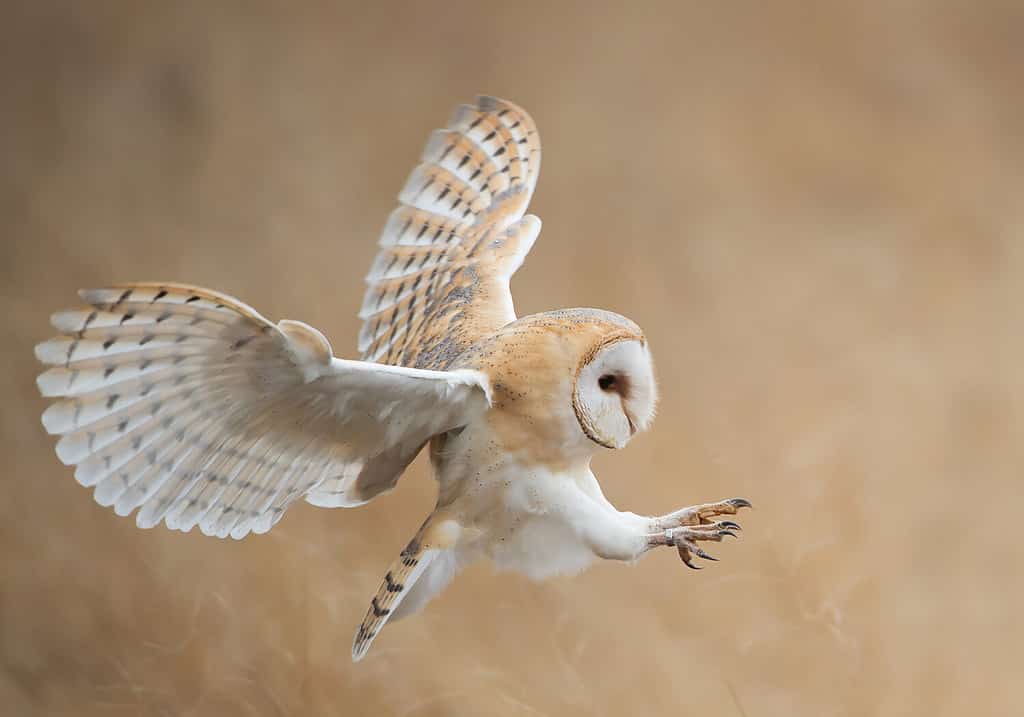
The barn owl’s facial shape allows it to hear the softest sounds to hunt its prey.
©MZPHOTO.CZ/Shutterstock.com
Barn owls are fairly common permanent residents in Oregon living in open country west of the Cascade Mountains and in agricultural areas east of the Cascades. Ghostly pale, these medium-sized owls are one of the most widespread of all species of birds. They are also the oldest of all species of owls in the world. They have heart-shaped facial disks and deep, dark eyes. The shape of their faces acts as a parabolic dish that collects the slightest sounds of its prey, allowing it to catch prey in total darkness.
Listen to the call of a barn owl.
#13 Northern Saw-Whet Owl

The striking yellow eyes of the northern saw-whet owl contrast against its small body.
©iStock.com/Bob Hilscher
Only eight inches long, this small owl is one of the most common forest owls in Oregon. The northern saw-whet owl lacks “ear” tufts and has a large head with wide, yellow eyes. It has brown or reddish coloring with white spots and furry toes, and a prominent white “V” above the eyes and beak.
“This owl breeds in low to mid-elevation coniferous and mixed deciduous/coniferous forests statewide. It is found at higher elevations to the tree line in lower numbers. In the Coast Range, this is the most common forest owl detected during nocturnal surveys,” according to the Oregon Department of Fish and Game.
Listen to the call of a northern saw-whet owl. Watch when the Montana Migration Project releases a northern saw-whet owl.
#14 Great Horned Owl
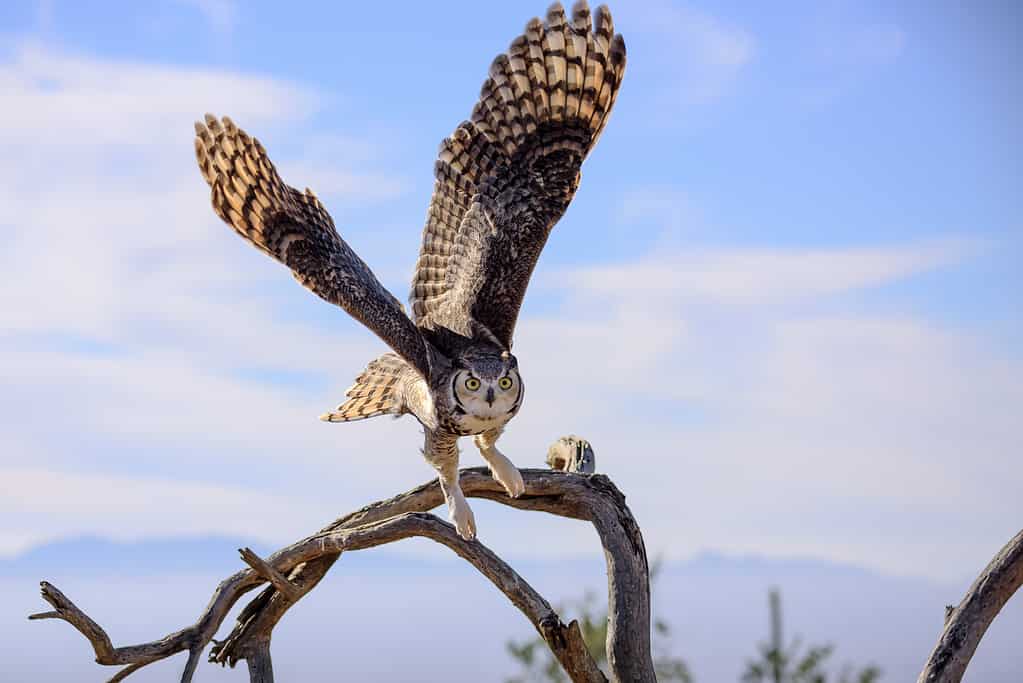
The great horned owl has the largest wingspan of any North American owl.
©iStock.com/kojihirano
Oregon’s most commonly encountered owl, the great horned owl gets its name from its distinctive feather tufts above its eyes that resemble horns. These large, powerful birds have massive talons that allow the great horned owl to capture prey larger than themselves. They have yellow eyes and coloration varies from dark brown in western Oregon to grayish-brown in southeastern areas of the state.
Listen to the sound of a great horned owl.
Oregon’s 14 Types of Owls Ranked from Rarest to Most Common
| Rank | Common Name | Scientific Name | Status |
|---|---|---|---|
| #1 | Snowy Owl | Bubo scandiacus | Globally Vulnerable |
| #2 | Northern Spotted Owl | Strix occidentalis caurina | · Federally Threatened · Oregon Conservation Strategy species of conservation concern – Threatened |
| #3 | Burrowing Owl | Athene cunicularia hypugaea | · Federal Species of Concern · Oregon Conservation Strategy species of conservation concern – Sensitive |
| #4 | Flammulated Owl | Psiloscops flammeolus | Oregon Conservation Strategy species of conservation concern – Sensitive |
| #5 | Great Gray Owl | Strix nebulosa | Oregon Conservation Strategy species of conservation concern – Sensitive |
| #6 | Short-Eared Owl | Asio flammeus | Oregon Conservation Strategy species of conservation concern – Sensitive |
| #7 | Boreal Owl | Aegolius funereus | Common |
| #8 | Barred Owl | Strix varia | Common |
| #9 | Long-Eared Owl | Asio otus | Common |
| #10 | Northern Pygmy Owl | Glaucidium gnoma | Common |
| #11 | Western Screech Owl | Megascops kennicottii | Common |
| #12 | Barn Owl | Tyto alba | Common |
| #13 | Northern Saw Whet Owl | Aegolius acadicus | Common |
| #14 | Great Horned Owl | Bubo virginianus | Common |
The photo featured at the top of this post is © kojihirano/iStock via Getty Images
Thank you for reading! Have some feedback for us? Contact the AZ Animals editorial team.






